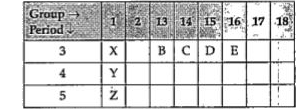The atomic masses of three elements X, Y and Z having similar chemical properties are 7, 23 and 39 respectively.
Which law of classification of elements is illustrated by this example?
Doberiner.s law of classification is illustrated by this example.
Similar Questions
The atomic masses of three elements X, Y and Z having similar chemical properties are 7, 23 and 39 respectively.
What could be the elements X, Y and Z be?
View SolutionThe atomic masses of three elements X, Y and Z having similar chemical properties are 7, 23 and 39 respectively.
Calculate the average atomic mass of element X and z.
View Solution
Knowledge Check
The pair of elements that have similar chemical properties are
ALithium and MagnesiumBBeryllium and BoronCAluminium and MagnesiumDcarbon and Nitrogen
The atomic masses of three elements X, Y and Z having similar chemical properties are 7, 23 and 39 respectively.
Compare the average atomic mass with atomic mass of Y.
View SolutionThe atomic masses of three elements X, Y and Z having similar chemical properties are 7, 23 and 39 respectively.
Give another example of a set of elements which can be classified according to this law.
View SolutionThe atomic masses of three elements X,Y and Z having similar chemical properties are 7,23 and 39 respectively
(a) Calculate the average atomic mass of elements X and Z
(b) How does the averge atomic mass of elements X and Z compare with the atomic mass of element Y
(c) Which law of classification of elements is illustrated by this example?
(d) What could the elements X,Y and Z be?
(e) Give another example of a set of elements which can be classified according to this law.
View SolutionThe pair of elements that have similar chemical properties are
View Solution
Identify the elements which have similar chemical properties as the element X.
View SolutionThree elements X, Y and Z have atomic numbers 7, 8 and 9 respectively.
Which of the three is most electronegative ? Why?
View SolutionThe atoms of same element having same chemical properties but different masses are called
View Solution
